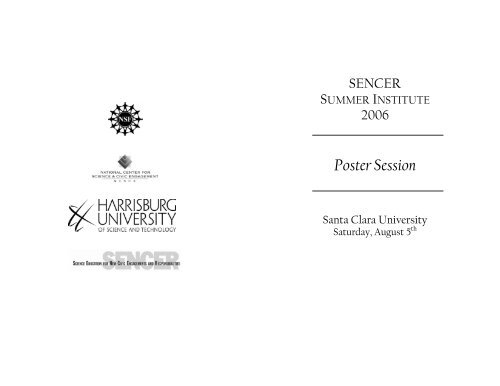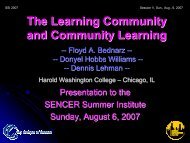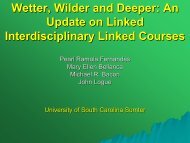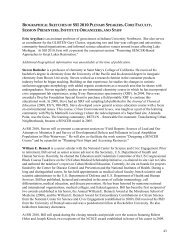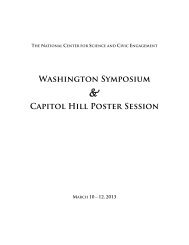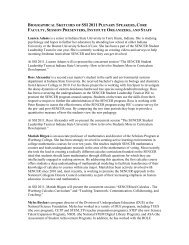Invited Poster Abstracts - SENCER
Invited Poster Abstracts - SENCER
Invited Poster Abstracts - SENCER
Create successful ePaper yourself
Turn your PDF publications into a flip-book with our unique Google optimized e-Paper software.
<strong>SENCER</strong>SUMMER INSTITUTE2006<strong>Poster</strong> SessionSanta Clara UniversitySaturday, August 5 th
NOTESWelcome to the SSI 2006 <strong>Poster</strong> Session! Thispart of the Summer Institute program has grownover the past few years to provide yet anotherway to share ideas, build community, and learnfrom each other. These are all valuable andimportant aspects of <strong>SENCER</strong>, and we hopethat this session furthers those aspects of yourexperience at SSI.One significant change this year is that theposters will be on display all day on Saturday, inaddition to an afternoon period focused solelyon the poster presentations. Our experience atpast SSI poster sessions is that the afternoonsession is never enough time to talk to all thepeople who are doing interesting work. So weencourage you to take some time throughout theday to come over to the Arts and SciencesLobby, look at the posters at your own pace,then use both the afternoon poster session andother time at SSI to find those people whoassembled the posters of interest to you and talkto them.Ultimately, our hope is that the conversationsthat begin around posters during one day at SSIwill continue throughout the remainder of theconference and after you return to your homeinstitutions.Matthew Fisher & Julie LowSSI 2006 <strong>Poster</strong> Session Co-Facilitators
Brigham Young UniversityCurriculum Design to PromoteCivic EngagementFor the past ten years, Brigham Young University hasbeen developing a non-majors course in Biology forincoming freshmen students. Our curriculum isdesigned to engage students in the learning processand help them experience the relevance it has in theirlives. Service-learning is a vital component of thecurriculum. It meets our objectives to (1) enhancestudent learning and retention of biological principles,(2) involve students in the biological issues in theircommunity, and (3) provide students with authenticproblems that directly relate to their academicexperience. It also emphasizes life-long learning andservice, an important part of the mission of BYU.Service-learning provides a catalyst for students tobecome informed and involved citizens for the rest oftheir lives.Gary Boothgary_booth@byu.eduWofford CollegeUndergraduate Computational ScienceMany significant scientific research questions areinterdisciplinary in nature, involving sciences,mathematics, and computer science in an area calledcomputational science. Despite the critical need forcomputational scientists, few programs and textbooksappropriate for undergraduates exist. NSF CCLIGrant 0087979 helped to fund development of anundergraduate Emphasis in Computational Science(ECS), creation of extensive online educationalmaterials (http://www.wofford.edu/ecs), andpromotion of such education nationally. ECSrequirements include a B.S. in science or mathematics,Programming, Data Structures, Calculus I, Data andVisualization, Modeling and Simulation, and a summerinternship involving computation in science.Application rich, web-accessible course modules areused in Data and Visualization. A textbook(Introduction to Computational Science Modeling andSimulation for the Sciences, Princeton UniversityPress, 2006) is based on materials developed forModeling and Simulation. As Wofford's experiencesdemonstrate, schools can develop effectiveundergraduate computational science programs thatprovide meaningful and needed educationalopportunities for students.Julie Lowjulie.low@gmail.eduAngela Shifletshifletab@wofford.eduJessica Rosenvalljessrose@byu.netGeorge Shifletshifletgw@wofford.edu
University of Wisconsin-Marshfield/Wood CountyFamily Values/Family Violence PilotImplementation CourseThe University of Wisconsin-Marshfield/WoodCounty will present the outcomes of our <strong>SENCER</strong>work. In the spring of 2006 the campus <strong>SENCER</strong> teamimplemented an interdisciplinary course composed ofthree thematically linked disciplines in statistics,computer science and women’s studies. All threedisciplines were connected through the servicelearning project and its theme Family Values/FamilyViolence.Andrea De Palmaandrea.depalma@uwc.eduBrigham Young University<strong>SENCER</strong>, General Education, and Biology100: Intelligently DesignedA general education at Brigham Young University isdefined as spiritually strengthening, intellectuallyenlarging, and character building, leading to lifelonglearning and service. Each area seeks intellectualenlargement, defined as enlarging their students'intellects by developing skills, breadth, and depth.Breadth and depth can be broadly interpreted - wesubmit they should be expressed as intellectual skillsfostering critical thinking. In a general educationBiology 100 course, <strong>SENCER</strong> ideals were implementedfocusing on development of intellectual skills asopposed to content-based format. Students exploredthe question: should “intelligent design theory” betaught as an alternative to evolution in public schools?A major student outcome was the development of theintellectual skills capable of fostering a moreresponsible citizenry better able to addresssociety-related issues.Rex Catesrex_cates@byu.eduStephanie Burdettstephanie_burdett@byu.eduRichard Swanswanr@byu.edu
Butler UniversityService-Learning and CommunityPartnershipsThe Butler University <strong>SENCER</strong> Team presents a posteron service-learning experiences involved with threeuniversity programs: an undergraduate researchprogram coupled with an outreach interaction withCrown Hill Cemetery, an epics program involvingcomputer science and engineering students, and anenvironmental service-learning activity. Thepresentation will focus on the challenges and dynamicsneeded to bring students, faculty, and externalconstituents together to form a team. The posterfocuses on the details of each of these universityactivities.Margaret Brabantmbrabant@butler.eduDonald Braiddbraid@butler.eduJoe Kirschjkirsch@butler.eduPanos Linoslinos@butler.eduUniversity of MontanaAir Toxics in Montana: StrengtheningResearch Partnership Between theUniversity of Montana and RegionalSchoolsCan science students in high school classes andtwo-year colleges be full partners with universityresearchers? We report a year's progress ofstrengthening a research consortium between theUniversity of Montana (UM), three high schools, anelementary school, and a tribal college. The projectsgoal is to overlay regional air quality data (hazardousair pollutants, HAPs, and particulate matter, PM-2.5)with health impacts, asthma and cardiovasculardisease). UM researchers train high school teachers inQAQC protocols so that small air sampling units canbe taken home by their students. Students complete asurvey about their home environment andsubsequently sample both inside and outside for HAPsand PM-2.5. Students from each school formulate theirown research questions as well as providing data forthe larger university-level study. The 2nd Annual HighSchool Health Science Symposium on May 17thbrought about 60 students and their mentors tocampus to share their findings. Two workshopsduring the summer of 2006 are aimed at extending andcurricularizing high school participation in futureproject activities.Stacy O’Reillysoreilly@butler.eduGaron Smithgaron.smith@umontana.edu
University of MinnesotaBiology, Society & the Environment: ACourse for Developing Science Literacy inLiberal Arts MajorsAn Introduction to Biology, Society, & the Environment is acourse designed for students in our College of LiberalArts who are interested in the Biology, Society, and theEnvironment interdisciplinary major. This courseintends to introduce basic science concepts byencouraging students to articulate sources of conflictbetween science and society. We use a modular formatin which topics are addressed in three-week units,beginning with a lecture-style introduction, but withemphasis on student-directed discussion. In-classactivities vary, but typically includemini-presentations, role-playing and moderatelystructured debate. Module topics include Evolutionand Society, Hormone Havoc, Your Genes YourChoices, Death, and The Great End-Holocene MassExtinction. Pre- and post-module written assignmentsreflect an individual student’s degree of mastery offundamental science concepts, along with his or herability to identify conflict sources and proposepractical mitigation strategies. While this course isnot intended to fulfill a singular science requirement(there is no lab and topics aren't selected to becomprehensive), assessment of this course will help todrive the design of a new introductory biology servicecourse for 1,500-2000 students per year.George Mason UniversityGains in Applied Science Literacy atGeorge Mason University<strong>SENCER</strong> has stimulated the development of moreeffective science-learning environments at GeorgeMason University. Courses developed with <strong>SENCER</strong>principles stimulate students to become more engagedcitizens, and to apply scientific thinking in broaddecision making processes. After the non-majorcourse, students indicate a significant increase in (1)confidence assessing science and math issues and (2)willingness to act on civic issues involving science.Two specific courses, The Natural World, a generalscience-based learning community course fornon-majors, and Mysteries of Migration, a core upperdivision course in the Conservation Studies curriculumin New Century College are presented here toexemplify the implementation of course reform at theUniversity.Thomas Woodtwood@gmu.eduSehoya Cotnerharri054@umn.edu
Holy Names UniversityUsing Cycles of Learning in ScienceEducation to Meet the Needs of DiverseLearnersOur goal as faculty at Holy Names University was toexpand the presentation of the science curriculum tocapture students who are traditionally under-engaged,and promote their involvement in the sciences. Increating curriculum to meet the needs of diverselearners, we drew on the work of Dr. BerniceMcCarthy. Her cycle of learning includes(1) establishing a personal connection/experience, (2)learning new information, (3) acting on, practicing,tinkering with new information, and (4) synthesizingto create, to teach, or to express the learning in a newway (e.g., local civic engagement). The faculty createdcycles of learning for central topics in their disciplines.Faculty discovered that students involved in a learningcycle exhibited heightened enthusiasm and morecomprehensive mastery of topics compared totraditional lecture presentation. Students also reportedhaving an enhanced ability to identify connectionsbetween lecture material and required researchassignments. Continued efforts on the part of faculty totransform lectures and assess student outcomes areon-going at the University.SciTech HighWhat Does <strong>SENCER</strong> Look Like in a HighSchool? SciTech High & HarrisburgUniversity: A Seamless EducationSciTech High, a small learning community of theHarrisburg School District, is a college prep highschool in Harrisburg, PA. While in our third year, it isthe first working with Harrisburg University.Through a cross-curricular approach we enhance ourstudents’ educational opportunities usingproject-based learning. Pennsylvania’s number oneindustry, agriculture, is the center of one such project.Tenth grade students perform research by tracingscientific and manufacturing production steps, cost,and any surrounding controversy of a product of theirchoice. Public education has been showcased at thePennsylvania Farm Show and at SciTech High asPresentations of Learning.Kevin Varanokvarano@scitechhigh.orgNancy Teskeyteskey@hnu.eduKimberly Mayfieldmayfield@hnu.eduJulia Smithsmith@hnu.eduErin Pittmanepittman@scitechhigh.orgThea Maestremaestre@hnu.edu
Saint Mary’s CollegeSampling the Soil and Dust of a Residencewith Lead-Based Paints: Applying FieldPortable XRF AnalysisA general science course performed a lead in soil anddust sampling experiment. The experiment reinforcedthe use of the spectroscopic method to quantify thelead and provided a formal risk assessment, since thestudents must evaluate their own exposure toradiation. Students sampled five soil positions arounda 1946 residence. EPA Method 6200 for soils wasemployed. The technique for sampling dust wasdemonstrated inside the house after soil sampling. Theaverage soil lead content for three dripline sampleswere 314, 651, 751 ppm and a field background was 58ppm. The class observed the variability in the /in situ/measurements. Students averaged spectral values andwrote short letters to the resident comparing the soillead values to U.S. EPA PRGs. The faculty recordedthe XRF spectral results on the lead dust wipes andcommunicated all the results. Students completed aSALG survey designed for the XRF experiment.Iowa State University<strong>SENCER</strong> Engineering: Engineering forSustainability and DevelopmentA multidisciplinary engineering course was developedand taught for the first time in the fall of 2005 at IowaState University. This course was set in the context ofthe problems of global sustainability and poverty in thedeveloping world. The course objectives were toenable students to incorporate sustainability intoengineering and development and to help studentsdevelop creative problem solving skills to be usedunder limited resources, economic constraints, and lessfortunate conditions. Students were divided intomultidisciplinary teams and spent the term working onanalysis or design projects. Most projects were set inthe developing world and were done in partnershipwith collaborators on location. Using the SALGmodified for an engineering course, we uncovered someevidence of learning gains in several areas. <strong>SENCER</strong>ideals applied to an engineering course have beenhelpful in developing the course in terms of a largeglobal problem and student learning objectives.Steve Freemansfreeman@iastate.eduSteven Bachoferbachofer@stmarys-ca.eduLoren Zacharyzach@iastate.eduSay Kee Ongskong@iastate.eduBrian Stewardbsteward@iastate.edu
Kapi’olani Community CollegeSleep & SocietyThis poster focuses on sleep science. Covered topicsinclude sleep deprivation, a common condition thatafflicts a quarter of the adult population, and theconsequences of being sleep deprived. Statistics will beshared from the National Sleep Foundation on TeenSleep, and the natural changes that effect sleep habitsin young adults and the debate revolving around schoolstart times, and from the National Highway TrafficSafety Administration (NHTSA) on sleep deprivationand driving. The following questions will be raisedwith this poster presentation: How do we educatefuture generations about the importance of sleep tohealth and well-being? How do we work sleep scienceinto teacher education courses? Could we create alearning community between the Science of Sleep anda teacher education course? What service learningactivities should students do related to educatingsociety about the importance of sleep?Robert Francobfranco@hawaii.eduRoosevelt UniversityA River Runs Through It: RedesigningQuantitative Analysis with an UrbanEnvironmental FocusRoosevelt University redesigned the sophomorequantitative analysis lecture and laboratory course in2004. The lecture includes standard coverage ofsolution equilibria, statistical analysis of data, andintroductory spectroscopy. However, the laboratoryhas been restructured to focus on analysis of localenvironmental samples. At the beginning of thesemester, students have the option to participate in asampling trip to obtain water and sediment samplesfrom various locations along the Chicago River’s north,main and south branches as it winds through the cityand becomes progressively more polluted. Standardquantitative analysis laboratory experiments have beenadapted for use with the Chicago River samples. Eachstudent completes each of these analyses on their ownstation, corresponding to one location along theChicago River. By the end of the semester, studentsamass data to document the city's impact on the riverswater quality; because samples are taken from theirown neighborhoods whenever possible, students'interest in the analyses is raised.Herve Collinherve@hawaii.eduVeronica Ogatavogata@hawaii.eduJudith Kirkpatrickkirkpatr@hawaii.eduJohn Randjrand@hawaii.eduKristen Leckronekleckron@roosevelt.edu
Northland CollegeA <strong>SENCER</strong>y Approach to Water Quality:Focusing on Undergraduate Education andCommunity-Based ResearchNorthland College is located on the southern shore ofChequamegon Bay of Lake Superior. It is also home tothe Sigurd Olson Environmental Research Institute,which involves students and staff in communityoutreach and research of environmental issues. Manyof the faculty and staff at Northland College and theInstitute address various aspects of water quality ofthis valuable and unspoiled resource in their classesand internships, but not with a coordinatedundergraduate educational objective. Because waterquality in Lake Superior and its associated drainages isa large, complex issue, including effects from asuperfund site in Chequamegon Bay, the faculty andstaff at Northland College and the Institute plan tobuild on the expertise and knowledge already in placeto make connections between several sciencedisciplines. They will develop a course or a block ofcourses that address regional water quality andprovide student community-based researchopportunities.La Salle UniversityIncorporating <strong>SENCER</strong> Ideals into aDatabase CourseTeaching the design, implementation, and issues ofdatabases often uses examples ranging from addressbooks to inventories to music collections. Anundergraduate course in Database ManagementSystems was enhanced to integrate the <strong>SENCER</strong> idealsthrough a variety of means. Preparation for the coursewas multiphased: attendance at the <strong>SENCER</strong> SummerInstitute 2005, followed by a <strong>SENCER</strong> House Call, andthen the offering of the course in the spring of 2006.This poster will demonstrate how the <strong>SENCER</strong> Idealswere incorporated through one-minute papers, currentevents discussions, and use of U.S. Census reports.Student teams designed and implemented projectswith a civic engagement purpose, such as addressingchildhood obesity and tracking hurricane Katrinavictims. Assessment included the SALG instrumentand a group processing instrument for the teamproject.Wendy Gormanwgorman@northland.eduMichael Gardnermgardner@northland.eduMargaret McManusmcmanus@lasalle.edu
Lesley UniversityCommunity-Based EnvironmentalResearch at Lesley UniversityThis poster highlights the developing communitybasedenvironmental research (CBER) program atLesley University. The syllabus for the new 1000 level<strong>SENCER</strong> course Urban Ecology of Cambridge will beavailable, as will the GIS technology used to supportthe research. The poster itself highlights thedevelopment of the program, including premises andgoals, community collaborations and connections,present and future work, and ideas for systematicintegration.Northland CollegeLearning Science & Civic Engagement byStaffing the Bad River WatershedAssociationA workshop course is required in the undergraduateEnvironmental Studies program at Northland College.In a workshop course, students do real work for a realclient. The class operates as a consulting firm with theinstructor as manager. A scope of services is negotiatedwith the client beforehand and students with a varietyof backgrounds figure out how to learn what they needto learn to accomplish the work. They also learn tooperate in multi-disciplinary teams and in the role ofstaff, that is, as experts but not decision makers.Students present their work to their client and receiveboth feedback and appreciation. Several semesters ofthe workshop course served the Bad River WatershedAssociation (BRWA), a citizen group that gatherswatershed information and promotes citizeninvolvement and stewardship. The poster explains theworkshop course, exhibits some student work andexplains learning outcomes and assessmenttechniques.Dorothy Lagerroosdlagerroos@northland.eduDavid Morimotomorimoto@lesley.edu
New York UniversityEnvironmental Restoration & BrownfieldAction: Inquiry-Based Approaches toTeaching and Learning EnvironmentalScienceBrownfield Action is a <strong>SENCER</strong> model developed atBarnard College and used at Connecticut College andLafayette College in hydrology and environmentalscience courses. This fall, New York University willuse aspects of Brownfield Action in EnvironmentalRestoration, a new seminar in critical thinking forundergraduate students. Environmental Restoration willexamine abandoned industrial sites (brownfields) thatare important for economic, environmental, andaesthetic reasons. Throughout the semester, legal,medical, municipal, geophysical, and hydrologic issuesas they apply to brownfields will be discussed during agroup study of a virtual brownfield that is beingconsidered for development as a shopping mall in arural community. Two books are used in the course -Rachel Carson’s Silent Spring and Jonathan Haar’s ACivil Action. Environmental Restoration is suited to theNYU students, many of whom are professionals whomight make decisions on federal, state, and localsocietal issues.Joseph Liddicoatjliddico@barnard.eduMetropolitan College of New YorkUnderstanding Asthma & ADD ThroughApplied StatisticsIn this undergraduate course students will explore theuse and interpretation of statistics, graphs and othermathematical tools in the ongoing quest to describe,predict and explain important health and mentalhealth phenomena such as asthma and ADD (attentiondeficit disorder). Course topics will includedescription vs. inference in statistics, variables,populations and samples, families of analytic methods,group differences, relations among variables, treatmentimplications, and public policy implications. Thesetopics will be applied to the emerging health crisis ofasthma and the emerging mental health crisis of ADDas special examples in the application andinterpretation of statistics. Students will beencouraged to pursue these or other examples ofinterest. Special consideration will be given to whatinformation is yielded by applied statistics, as well ashow one can be fooled by them. As a result of thecourse, it is expected that students will become moreknowledgeable consumers of statistical research. Interms of Bloom's revised taxonomy of educationalobjectives, emphasis will be on the acquisition of basicstatistical knowledge, comprehension of selectedstatistical tests, the evaluation of their use and theirapplication in selected contexts (e.g. asthma and ADDpolicy).Peter Bowerpb119@columbia.eduWilliam Courywilliam.coury@nyu.eduCatherine Kingcasey.king@nyu.eduGeorge Siderisg.sideris@verizon.netRichard Grallorgrallo@metropolitan.edu
Metropolitan College of New YorkBiology in the City: The <strong>SENCER</strong>izing of aHuman Biology CourseMetropolitan College of New York will initiate ageneral education core curriculum for itsundergraduate majors. One of the new courses, ahuman biology and life sciences course designed forhuman services, American urban studies, and businessmajors, was pilot-tested during 2005. This courseserves as a springboard for future science coursesstudents will take after they enter their majors. Inshort, this course presents human biology in a way thatconnects the topic directly with the life sciences andissues of health. It starts with the concept of a healthybody and mechanisms that enable the body to maintainbiological order. Students explore how human biologyties to current issues and problems that are relevant totheir lives, as well as others living in different parts ofthe world. Topics include human body structure andfunction, reproduction and development, and genetics.An emphasis is placed on the application of principlesto current issues in the life sciences, including, but notlimited to, common human diseases, geneticengineering, and reproductive technology. A portion ofthe coursework may be tied to the Purpose courseregarding global human biology issues. Overallstrategies include pair- and group-learning activities,individual and group presentation, issues debate,reflection pieces, case studies, film reviews, andstudent-resource engagement development.Montgomery CollegeIntroducing Writing Assignments into aChemistry Course for Non-Science MajorsTwo writing projects are included in the non-sciencemajor course Chemistry and Society. The first is aletter to a government official or civic leaderconcerning an environmental issue. The instructorapproves selection of issues and officials. The secondproject is a researched executive summary about awidely used pharmaceutical listed in Chemical andEngineering News Online. This summary is directed toa specific audience and may contain recommendationsfor action. Students give oral presentations of theirexecutive summaries, which are evaluated by fellowstudents. Both projects are graded for content; extracredit is given for using the Writing and ReadingCenter (a Montgomery College resource) for revision.The purpose of these projects is to motivate studentsto become active in civic issues, to illustrate means ofcommunicating concerns to civic leaders, to introducestudents to the Writing and Reading Center, and toillustrate the value of revising one’s writing.Ralph Bainralph.bain@montgomerycollege.eduHeide Hlawatyhhlawaty@metropolitan.eduGregory Wahlgregory.wahl@montgomerycollege.edu


